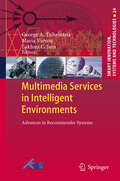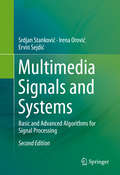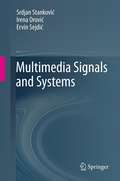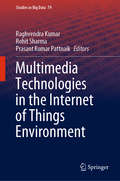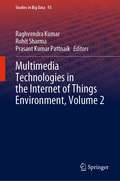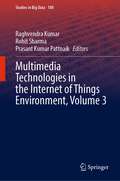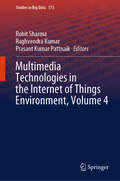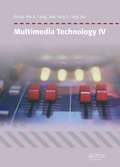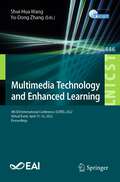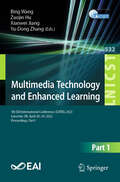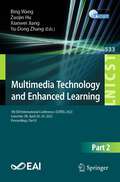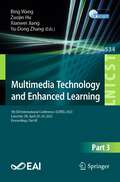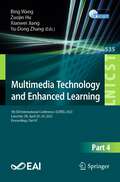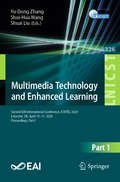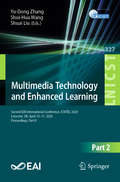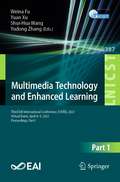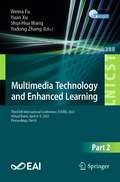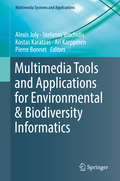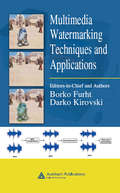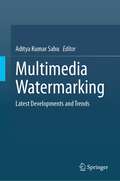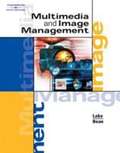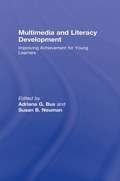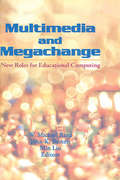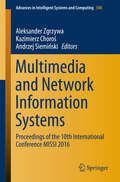- Table View
- List View
Multimedia Services in Intelligent Environments: Advances in Recommender Systems
by Lakhmi C. Jain Maria Virvou George A. TsihrintzisMultimedia services are now commonly used in various activities in the daily lives of humans. Related application areas include services that allow access to large depositories of information, digital libraries, e-learning and e-education, e-government and e-governance, e-commerce and e-auctions, e-entertainment, e-health and e-medicine, and e-legal services, as well as their mobile counterparts (i.e., m-services). Despite the tremendous growth of multimedia services over the recent years, there is an increasing demand for their further development. This demand is driven by the ever-increasing desire of society for easy accessibility to information in friendly, personalized and adaptive environments. In this book at hand, we examine recent Advances in Recommender Systems. Recommender systems are crucial in multimedia services, as they aim at protecting the service users from information overload. The book includes nine chapters, which present various recent research results in recommender systems. This research book is directed to professors, researchers, application engineers and students of all disciplines who are interested in learning more about recommender systems, advancing the corresponding state of the art and developing recommender systems for specific applications.
Multimedia Signals and Systems
by Srdjan Stanković Ervin Sejdić Irena OrovicMultimedia signals include different data types (text, sound, graphics, picture, animations, video, etc.), which can be time-dependent (sound, video and animation) or spatially-dependent (images, text and graphics). Hence, the multimedia systems represent an interdisciplinary cross-section of the following areas: digital signal processing, computer architecture, computer networks and telecommunications. Multimedia Signals and Systems is an introductory text, designed for students or professionals and researchers in other fields, with a need to learn the basics of signals and systems. A considerable emphasis is placed on the analysis and processing of multimedia signals (audio, images, video). Additionally, the book connects these principles to other important elements of multimedia systems such as the analysis of optical media, computer networks, QoS, and digital watermarking.
Multimedia Signals and Systems
by Srdjan Stanković Ervin Sejdić Irena OrovicMultimedia signals include different data types (text, sound, graphics, picture, animations, video, etc.), which can be time-dependent (sound, video and animation) or spatially-dependent (images, text and graphics). Hence, the multimedia systems represent an interdisciplinary cross-section of the following areas: digital signal processing, computer architecture, computer networks and telecommunications. Multimedia Signals and Systems is an introductory text, designed for students or professionals and researchers in other fields, with a need to learn the basics of signals and systems. A considerable emphasis is placed on the analysis and processing of multimedia signals (audio, images, video). Additionally, the book connects these principles to other important elements of multimedia systems such as the analysis of optical media, computer networks, QoS, and digital watermarking.
Multimedia Technologies in the Internet of Things Environment (Studies in Big Data #79)
by Rohit Sharma Prasant Kumar Pattnaik Raghvendra KumarThis book provides theoretical and practical approach in the area of multimedia and IOT applications and performance analysis. Further, multimedia communication, deep learning models to multimedia data and the new (IOT) approaches are also covered. It addresses the complete functional framework in the area of multimedia data, IOT and smart computing techniques. The book proposes a comprehensive overview of the state-of-the-art research work on multimedia analysis in IOT applications. It bridges the gap between multimedia concepts and solutions by providing the current IOT frameworks, their applications in multimedia analysis, the strengths and limitations of the existing methods, and the future directions in multimedia IOT analytics.
Multimedia Technologies in the Internet of Things Environment, Volume 2 (Studies in Big Data #93)
by Rohit Sharma Prasant Kumar Pattnaik Raghvendra KumarThis book proposes a comprehensive overview of the state-of-the-art research work on multimedia analysis in IoT applications. This is a second volume by editors which provides theoretical and practical approach in the area of multimedia and IOT applications and performance analysis. Further, multimedia communication, deep learning models to multimedia data, and the new (IOT) approaches are also covered. It addresses the complete functional framework in the area of multimedia data, IoT, and smart computing techniques. It bridges the gap between multimedia concepts and solutions by providing the current IOT frameworks, their applications in multimedia analysis, the strengths and limitations of the existing methods, and the future directions in multimedia IOT analytics.
Multimedia Technologies in the Internet of Things Environment, Volume 3 (Studies in Big Data #108)
by Rohit Sharma Prasant Kumar Pattnaik Raghvendra KumarThis book proposes a comprehensive overview of the state-of-the-art research work on multimedia analysis in IoT applications. This is a third volume by editors which provides theoretical and practical approach in the area of multimedia and IOT applications and performance analysis. Further, multimedia communication, deep learning models to multimedia data, and the new (IOT) approaches are also covered. It addresses the complete functional framework in the area of multimedia data, IoT, and smart computing techniques. It bridges the gap between multimedia concepts and solutions by providing the current IOT frameworks, their applications in multimedia analysis, the strengths and limitations of the existing methods, and the future directions in multimedia IOT analytics.
Multimedia Technologies in the Internet of Things Environment, Volume 4 (Studies in Big Data #173)
by Rohit Sharma Prasant Kumar Pattnaik Raghvendra KumarThis book proposes a comprehensive overview of the state-of-the-art research work on multimedia analysis in IoT applications. This is a fourth volume by editors which provides theoretical and practical approaches in the areas of multimedia and IoT applications and performance analysis. Further, multimedia communication, deep learning models to multimedia data, and the new (IoT) approaches are also covered. It addresses the complete functional framework in the areas of multimedia data, IoT, and smart computing techniques. It bridges the gap between multimedia concepts and solutions by providing the current IoT frameworks, their applications in multimedia analysis, the strengths and limitations of the existing methods, and the future directions in multimedia IoT analytics.
Multimedia Technology IV: Proceedings of the 4th International Conference on Multimedia Technology, Sydney, Australia, 28-30 March 2015
by Aly A. Farag Jian Yang Feng JiaoMultimedia Technology IV is a collection of papers from the 4th International Conference on Multimedia Technology (ICMT 2015, Sydney, Australia, 28-29 March 2015). The book discusses a wide range of topics, including: Image and signal processing Video and audio processing Multimedia data communication and transmission, and Multimedia tools. Presenting recent advances and new techniques and applications in image and signal processing, video and audio processing, multimedia data communication and transmission, and multimedia tools, Multimedia Technology IV will be of interest to academics and professionals involved in the field of multimedia technology.
Multimedia Technology and Enhanced Learning: 4th EAI International Conference, ICMTEL 2022, Virtual Event, April 15-16, 2022, Proceedings (Lecture Notes of the Institute for Computer Sciences, Social Informatics and Telecommunications Engineering #446)
by Shui-Hua Wang Yu-Dong ZhangThis proceedings, ICMTEL 2022, constitutes the refereed proceedings of the 4th International Conference on Multimedia Technology and Enhanced Learning, ICMTEL 2022, held in April 2022. Due to the COVID-19 pandemic the conference was held virtually.The 59 revised full papers have been selected from 188 submissions. They were organized in topical sections as follows: internet of things and communication; education and enterprise; machine learning; big data and signal processing; workshop of data fusion for positioning and navigation; and workshop of intelligent systems and control.
Multimedia Technology and Enhanced Learning: 5th EAI International Conference, ICMTEL 2023, Leicester, UK, April 28-29, 2023, Proceedings, Part I (Lecture Notes of the Institute for Computer Sciences, Social Informatics and Telecommunications Engineering #532)
by Yu-Dong Zhang Bing Wang Zuojin Hu Xianwei JiangThe four-volume set LNICST 532, 533, 534 and 535 constitutes the refereed proceedings of the 5th EAI International Conference on Multimedia Technology and Enhanced Learning, ICMTEL 2023, held in Leicester, UK, during April 28-29, 2023.The 121 papers presented in the proceedings set were carefully reviewed and selected from 285 submissions. They were organized in topical sections as follows: AI-based education and learning systems; medical and healthcare; computer vision and image processing; data mining and machine learning; workshop 1: AI-based data processing, intelligent control and their applications; workshop 2: intelligent application in education; and workshop 3: the control and data fusion for intelligent systems.
Multimedia Technology and Enhanced Learning: 5th EAI International Conference, ICMTEL 2023, Leicester, UK, April 28-29, 2023, Proceedings, Part II (Lecture Notes of the Institute for Computer Sciences, Social Informatics and Telecommunications Engineering #533)
by Yu-Dong Zhang Bing Wang Zuojin Hu Xianwei JiangThe four-volume set LNICST 532, 533, 534 and 535 constitutes the refereed proceedings of the 5th EAI International Conference on Multimedia Technology and Enhanced Learning, ICMTEL 2023, held in Leicester, UK, during April 28-29, 2023.The 121 papers presented in the proceedings set were carefully reviewed and selected from 285 submissions. They were organized in topical sections as follows: AI-based education and learning systems; medical and healthcare; computer vision and image processing; data mining and machine learning; workshop 1: AI-based data processing, intelligent control and their applications; workshop 2: intelligent application in education; and workshop 3: the control and data fusion for intelligent systems.
Multimedia Technology and Enhanced Learning: 5th EAI International Conference, ICMTEL 2023, Leicester, UK, April 28-29, 2023, Proceedings, Part III (Lecture Notes of the Institute for Computer Sciences, Social Informatics and Telecommunications Engineering #534)
by Yu-Dong Zhang Bing Wang Zuojin Hu Xianwei JiangThe four-volume set LNICST 532, 533, 534 and 535 constitutes the refereed proceedings of the 5th EAI International Conference on Multimedia Technology and Enhanced Learning, ICMTEL 2023, held in Leicester, UK, during April 28-29, 2023.The 121 papers presented in the proceedings set were carefully reviewed and selected from 285 submissions. They were organized in topical sections as follows: AI-based education and learning systems; medical and healthcare; computer vision and image processing; data mining and machine learning; workshop 1: AI-based data processing, intelligent control and their applications; workshop 2: intelligent application in education; and workshop 3: the control and data fusion for intelligent systems.
Multimedia Technology and Enhanced Learning: 5th EAI International Conference, ICMTEL 2023, Leicester, UK, April 28-29, 2023, Proceedings, Part IV (Lecture Notes of the Institute for Computer Sciences, Social Informatics and Telecommunications Engineering #535)
by Yu-Dong Zhang Bing Wang Zuojin Hu Xianwei JiangThe four-volume set LNICST 532, 533, 534 and 535 constitutes the refereed proceedings of the 5th EAI International Conference on Multimedia Technology and Enhanced Learning, ICMTEL 2023, held in Leicester, UK, during April 28-29, 2023.The 121 papers presented in the proceedings set were carefully reviewed and selected from 285 submissions. They were organized in topical sections as follows: AI-based education and learning systems; medical and healthcare; computer vision and image processing; data mining and machine learning; workshop 1: AI-based data processing, intelligent control and their applications; workshop 2: intelligent application in education; and workshop 3: the control and data fusion for intelligent systems.
Multimedia Technology and Enhanced Learning: Second EAI International Conference, ICMTEL 2020, Leicester, UK, April 10-11, 2020, Proceedings, Part I (Lecture Notes of the Institute for Computer Sciences, Social Informatics and Telecommunications Engineering #326)
by Shuai Liu Shui-Hua Wang Yu-Dong ZhangThis two-volume book constitutes the refereed proceedings of the Second International Conference on Multimedia Technology and Enhanced Learning, ICMTEL 2020, held in Leicester, United Kingdom, in April 2020. Due to the COVID-19 pandemic all papers were presented in YouTubeLive. The 83 revised full papers have been selected from 158 submissions. They describe new learning technologies which range from smart school, smart class and smart learning at home and which have been developed from new technologies such as machine learning, multimedia and Internet of Things.
Multimedia Technology and Enhanced Learning: Second EAI International Conference, ICMTEL 2020, Leicester, UK, April 10-11, 2020, Proceedings, Part II (Lecture Notes of the Institute for Computer Sciences, Social Informatics and Telecommunications Engineering #327)
by Shuai Liu Shui-Hua Wang Yu-Dong ZhangThis two-volume book constitutes the refereed proceedings of the Second International Conference on Multimedia Technology and Enhanced Learning, ICMTEL 2020, held in Leicester, United Kingdom, in April 2020. Due to the COVID-19 pandemic all papers were presented in YouTubeLive. The 83 revised full papers have been selected from 158 submissions. They describe new learning technologies which range from smart school, smart class and smart learning at home and which have been developed from new technologies such as machine learning, multimedia and Internet of Things.
Multimedia Technology and Enhanced Learning: Third EAI International Conference, ICMTEL 2021, Virtual Event, April 8–9, 2021, Proceedings, Part I (Lecture Notes of the Institute for Computer Sciences, Social Informatics and Telecommunications Engineering #387)
by Yuan Xu Shui-Hua Wang Weina Fu Yudong ZhangThis two-volume book constitutes the refereed proceedings of the 3rd International Conference on Multimedia Technology and Enhanced Learning, ICMTEL 2021, held in April 2021. Due to the COVID-19 pandemic the conference was held virtually. The 97 revised full papers have been selected from 208 submissions. They describe new learning technologies which range from smart school, smart class and smart learning at home and which have been developed from new technologies such as machine learning, multimedia and Internet of Things.
Multimedia Technology and Enhanced Learning: Third EAI International Conference, ICMTEL 2021, Virtual Event, April 8–9, 2021, Proceedings, Part II (Lecture Notes of the Institute for Computer Sciences, Social Informatics and Telecommunications Engineering #388)
by Yuan Xu Shui-Hua Wang Weina Fu Yudong ZhangThis two-volume book constitutes the refereed proceedings of the 3rd International Conference on Multimedia Technology and Enhanced Learning, ICMTEL 2021, held in April 2021. Due to the COVID-19 pandemic the conference was held virtually. The 97 revised full papers have been selected from 208 submissions. They describe new learning technologies which range from smart school, smart class and smart learning at home and which have been developed from new technologies such as machine learning, multimedia and Internet of Things.
Multimedia Tools and Applications for Environmental & Biodiversity Informatics (Multimedia Systems and Applications)
by Pierre Bonnet Stefanos Vrochidis Alexis Joly Kostas Karatzas Ari KarppinenThis edited volume focuses on the latest and most impactful advancements of multimedia data globally available for environmental and earth biodiversity. The data reflects the status, behavior, change as well as human interests and concerns which are increasingly crucial for understanding environmental issues and phenomena. This volume addresses the need for the development of advanced methods, techniques and tools for collecting, managing, analyzing, understanding and modeling environmental & biodiversity data, including the automated or collaborative species identification, the species distribution modeling and their environment, such as the air quality or the bio-acoustic monitoring. Researchers and practitioners in multimedia and environmental topics will find the chapters essential to their continued studies.
Multimedia Watermarking Techniques and Applications (Internet And Communications Ser.)
by Darko KirovskiIntellectual property owners must continually exploit new ways of reproducing, distributing, and marketing their products. However, the threat of piracy looms as a major problem with digital distribution and storage technologies. Multimedia Watermarking Techniques and Applications covers all current and future trends in the design of modern
Multimedia Watermarking: Latest Developments and Trends
by Aditya Kumar SahuMultimedia watermarking is a key ingredient for integrity verification, transaction tracking, copyright protection, authentication, copy control, and forgery detection. This book provides an extensive survey from the fundamentals to cutting-edge digital watermarking techniques. One of the crucial aspects of multimedia security is the ability to detect forged/tampered regions from the multimedia object. In this book, we emphasized how tampering detection, localization, and recovery of manipulated information not only limits but also eliminates the scope of unauthorized usage. Finally, this book provides the groundwork for understanding the role of intelligent machines and blockchain in achieving better security in multimedia watermarking. Readers will find it easy to comprehend the wide variety of applications, theoretical principles, and effective solutions for protecting intellectual rights soon after reading this book.
Multimedia and Image Management
by Karen Bean Susan LakeMultimedia and Image Management prepares students for a business world in which they will be expected to use business-standard software applications and to complete projects and solve problems. The applications include word processing, presentation, digital photography, image manipulation, animation, and speech recognition. This text teaches students the more creative end of business technology.
Multimedia and Image Management: Activities
by Karen Bean Susan E. L. LakeMost of the applications discussed within this book are available for both the Windows and Macintosh operating systems, and the activities described can be worked easily on either system.
Multimedia and Literacy Development: Improving Achievement for Young Learners
by Susan B. Neuman Adriana G. BusRepresenting the state of the art in multimedia applications and their promise for enhancing early literacy development, this volume broadens the field of reading research by looking beyond print-only experiences to young readers’ encounters with multimedia stories on the Internet and DVD. Multimedia storybooks include, in addition to static pictures and written text, features such as oral text, animations, sounds, zooms, and scaffolds designed to help convey meaning. These features are changing how young children read text, and also provide technology-based scaffolds for helping struggling readers. Multimedia and Literacy Development reports experimental research and practices with multimedia stories indicating that new dimensions of media contribute to young children’s ability to understand stories and to read texts independently. This is the first synthesis of evidence-based research in this field. Four key themes are highlighted: Understanding the multimedia environment for learning Designing multimedia applications for learning New approaches to storybook reading Multimedia applications in classroom instruction. Written in jargon-free language for an international audience of students in university courses on literacy and information technology, researchers, policymakers, program developers, and media specialists, this volume is essential reading for all professionals interested in early literacy and early interventions.
Multimedia and Megachange: New Roles for Educational Computing
by W Michael Reed John K BurtonThe use of multimedia strikes at the very heart of traditional teaching and learning methods, and is changing the way educators think about the whole process of teaching and learning. Multimedia and Megachange spurs ideas for the use of interactive technology to revolutionize teaching and learning. It describes and analyzes issues and trends that are currently setting a research and development agenda for educators.Contributors to this volume explore all fronts on which computer technology are changing the educational process:concept and theoryresearchapplicationdesignMultimedia and Megachange opens up the exciting world of how technology is dramatically changing how teachers teach and students learn. It also highlights spin-off changes for classroom management, greater sources of information, and improved evaluation and grading techniques.
Multimedia and Network Information Systems
by Aleksander Zgrzywa Kazimierz Choroś Andrzej SiemińskiDiscusses a broad scope of subject matters including multimedia systems in their widest sense, web systems and network technologies. This monograph also includes texts which deals with traditional information systems that draw on the experience of the multimedia and network systems.
